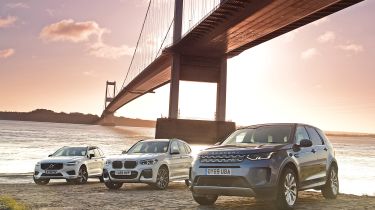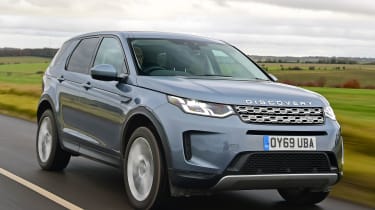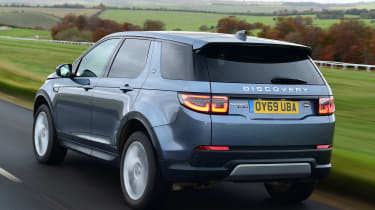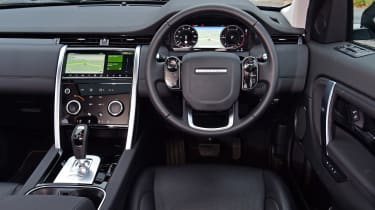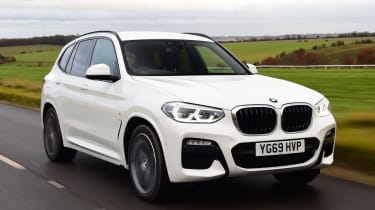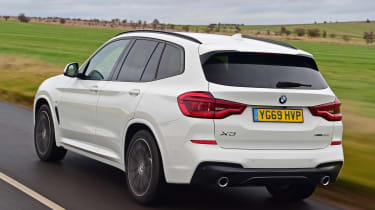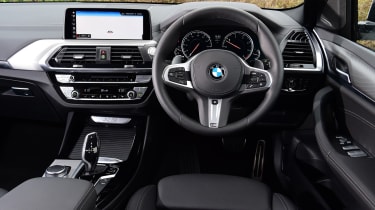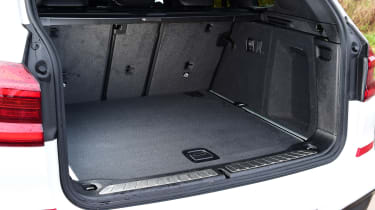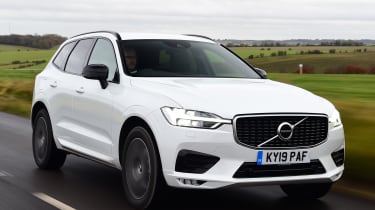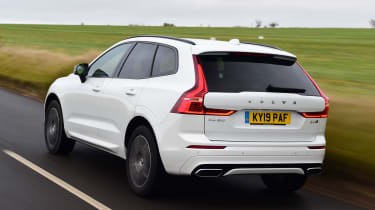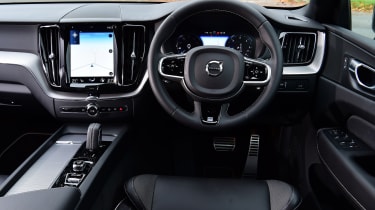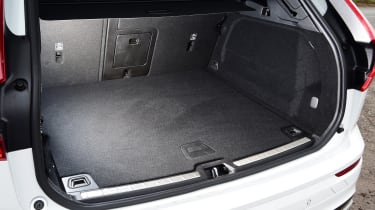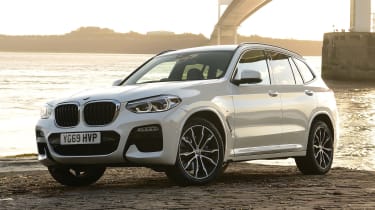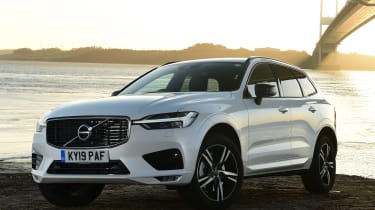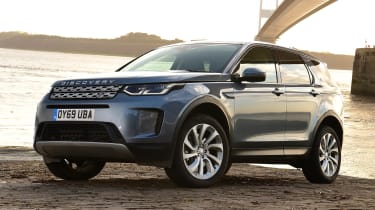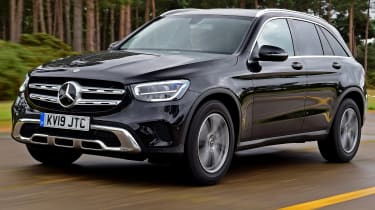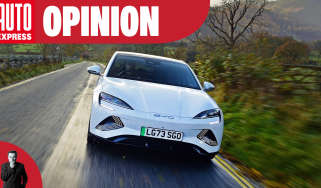Land Rover Discovery Sport vs BMW X3 vs Volvo XC60
New Land Rover Discovery Sport, BMW X3 and Volvo XC60 aim to bridge the gap between rugged 4x4 and comfortable road car
This is the new Land Rover Discovery Sport – and while it might not look all that different from the outside, there have been plenty of changes under the skin. This is all part of Land Rover’s mid-life refresh for the big-selling British SUV, which the brand hopes will bring the car in line with newer rivals.
We’ve brought it together here with two key models – one that currently sits in top spot in the mid-size premium SUV class, and a previous benchmark. The former is the BMW X3, a car that mixes performance, comfort and tech to great effect. The latter is the Volvo XC60, another big-selling SUV that brings luxury, refinement and quality.
In this test we’ll find out whether the changes made to the Discovery Sport have brought it up to speed with these rivals. The winner will need to combine comfort and luxury with tech and efficiency, because buyers will be looking for a car that can fit into every area of their lives. Practicality will be another important consideration as a result, since these cars are often bought as family transport – and that means safety will need to be strong, too.
Land Rover Discovery Sport
| Model: | Land Rover Discovery Sport D180 SE |
| Price: | £43,175 |
| Engine: | 2.0-litre 4cyl diesel |
| Power: | 178bhp |
| 0-60mph: | 9.9 seconds |
| Test economy: | 32.1mpg/7.1mpl |
| CO2/tax: | 155g/km/£465 |
The Land Rover Discovery Sport’s styling hasn’t changed much, but since it has always been a big-selling model, we can easily see why the Brit brand has left the looks alone. The D180 SE costs £43,175.
Used - available now

2023 Land Rover
Discovery Sport
40,215 milesAutomaticPetrol1.5L
Cash £24,230
2023 Land Rover
Discovery Sport
26,368 milesAutomaticPetrol1.5L
Cash £27,914
2023 Land Rover
Discovery Sport
33,484 milesAutomaticPetrol1.5L
Cash £28,113
2023 Land Rover
Discovery Sport
42,636 milesAutomaticPetrol2.0L
Cash £24,325Design & engineering
There's lots of new tech under the Discovery Sport’s skin, with one of the most significant upgrades being a move to 48V mild-hybrid tech for the engine range. This brings it into line with the Volvo here, which in B4 (D) form also has this kit to improve efficiency, thanks to a small electric boost. The tech uses energy regained while braking to reduce load on the engine.
It’s teamed with a more familiar 178bhp 2.0-litre Ingenium diesel engine in this D180 car. There’s a new gearbox, though, this time with nine speeds. Four-wheel drive is standard on all but the entry-level D150 model, which is also the only version available with a manual gearbox.
Another change is that the Disco Sport is based on the Premium Transverse Architecture (an update of the previous chassis), stiffened for better rigidity and upgraded to accommodate a full-on plug-in hybrid version that will rival the X3 xDrive30e and XC60 T8. This D180 SE comes with Land Rover’s Terrain Response 2, which makes it one of the class’s best off-roaders, and there’s also hill descent control and torque vectoring. Adaptive dampers are £800.
Another key area that’s been updated for 2019 is the interior, which now features a 10-inch touchscreen infotainment system and a digital instrument cluster, again bringing it into line with its rivals here. The system comes with Android Auto and Apple CarPlay as well as sat-nav, and other standard kit on the SE model includes traffic-sign recognition, blind-spot assist, a powered tailgate, 19-inch alloys, LED headlights and heated seats.
The cabin layout has been changed slightly, with new air-con controls that, while higher-tech than before, are a bit fiddly to use. The quality of the interior is good, with premium-looking materials that match those in the BMW and Volvo.
Driving
Even though the Discovery Sport’s engine is the least powerful here, at 178bhp against both rivals’ 187bhp, it has a maximum of 430Nm of torque at 1,500rpm, which beats the BMW by 30Nm and Volvo by 10Nm. This means it feels more than punchy enough at low revs, yet it falls off quickly and the Land Rover’s power disadvantage is certainly felt when pushing the engine a bit harder.
It was well behind both rivals in our tests from 0-60mph, taking 9.9 seconds; the BMW was 1.9 seconds in front and the Volvo 1.7 seconds. This is because both rivals are lighter and more powerful, while the new nine-speed gearbox in the Land Rover also contributed to the deficit.
It’s a disappointing unit, because while it shifts smoothly when you’re taking things easy, it struggles to respond when you demand more of it. This is most evident when you put your foot down in auto mode, because it takes a long time to kick down, but it’s also slower to shift manually than both rivals’. With nine ratios, we weren’t able to record an in-gear figure for 30-50mph in third, because it can’t reach 50mph in that gear. The same test in fourth took 3.8 seconds, which placed the car in between its rivals; the X3 took 3.4 seconds and the XC60 4.2.
The new mild-hybrid system is barely noticeable, and the main benefit of it is a slightly smoother stop-start system. The engine is noisier than the BMW’s motor, but it’s about on par with the gruffer unit in the XC60. Similarly, the Discovery Sport’s focus on comfort means it rides about as smoothly as its Swedish rival here, with the Volvo having a slight edge – yet the X3 is more comfortable than both SUVs, while it’s also more fun to drive. The Land Rover is agile enough, but it suffers from body roll that isn’t quite in sync with the chassis. There’s plenty of grip, but the Discovery Sport does feel top-heavy.
Practicality
The Discovery Sport is the only model here that’s available with seven seats, although Land Rover lists it as a 5+2. It’s easy to see why, because the rearmost seats are very small and adults will have a hard time fitting into them. It’s still a huge benefit to usability, though, and there’s seemingly no impact on boot space; with 897 litres with only the rearmost seats folded, it’s the biggest here. The BMW has 550 litres, and the Volvo 483.
With a towing capacity of 2,200kg, it’s a decent choice for those with trailers or a caravan to pull, although the XC60 is able to haul more, at 2,400kg.
Ownership
Land Rover finished 20th overall in our 2019 Driver Power satisfaction survey, behind Volvo but ahead of BMW – they came in 13th and 25th respectively. All three cars have a five-star rating from Euro NCAP, and the Discovery Sport has plenty of safety kit, beating both rivals for tech. It has blind-spot assist, traffic-sign recognition, lane-keep assist, a reversing camera and AEB – and all are standard, unlike on the X3 and XC60.
Running costs
Strong residual values on the three cars here mean they each make a decent ownership proposition. However, it’s all relative; our experts predict that the Land Rover will hold on to 47 per cent of its value after three years, which is a loss of £22,874. That’s a little more than the X3 drops in the same period (£22,615), which is a residual value of 48.6 per cent. The XC60 loses the most, at £24,410, thanks to its residual figure of 43.5 per cent.
Testers’ notes
“While many owners won’t take their car off road, the Land Rover lives up to its name. With its various low-traction driving modes, it will be a good choice for those looking to head off the tarmac.”
BMW X3
| Model: | BMW X3 xDrive20d M Sport |
| Price: | £44,015 |
| Engine: | 2.0-litre 4cyl diesel |
| Power: | 187bhp |
| 0-60mph: | 8.0 seconds |
| Test economy: | 33.5mpg/7.4mpl |
| CO2/tax: | 133g/km/£465 |
As our current class-leader, the X3 is the car the new Discovery Sport has to beat. It’s a little more expensive in xDrive20d M Sport form, so we’ll find out here if it’s worth the extra outlay.
Design & engineering
This third-generation BMW X3 is based on the CLAR platform, so it shares parts with the 3 Series saloon, as well as the larger 5 Series and X5. There’s a range of four- and six-cylinder engines available as a result, but to match the Discovery Sport’s specification, we’re testing the four-wheel-drive xDrive20d model here.
It uses a 2.0-litre four-cylinder diesel and an automatic gearbox, just like its two competitors on test. Its 187bhp output means it’s a little behind the Volvo for power, because this car has 194bhp, but both models beat the Land Rover’s 178bhp. At 1,825kg, it’s no lightweight, yet the X3 is still ahead of its rivalsin this area. The XC60 weighs 1,881kg in B4 (D) spec, while the Discovery Sport weighs 1,953kg. This has benefits for handling, ride quality and running costs.
The BMW’s interior is built to a high standard, and features enough technology to justify the car’s premium price tag. The comfortable driving position and seats complement the wrap-around cabin, which, while a little less spacious than its rivals here, feels more driver-focused.
The X3 has plenty of equipment, too, including 19-inch alloy wheels, heated leather seats, a 10.25-inch digital dash and 12.3-inch infotainment display with nav, connected services and Apple CarPlay.
Our M Sport model comes with sportier suspension, along with plenty of cosmetic upgrades, but it still rides smoothly. Adaptive dampers are available as part of the M Sport Plus package, which also adds 20-inch alloy wheels, bigger brakes and variable-rate steering. However, it’s pricey, at £2,200 – and since the standard set-up is very well judged, we’d stick with that instead.
Driving
The X3 rides more smoothly than its rivals. There are fewer vibrations and smaller movements on the motorway, and even at s`lower speeds the BMW deals with potholes and rougher roads very well. The others aren’t uncomfortable, but the X3 is slightly more composed – and that settled feel means it’s also better to drive than its rivals here.
Its steering weight is good, and even though the wheel rim is a bit too thick, it’s more satisfying to use than the others’ set-ups. It’s also more agile, with less body roll and more grip in fast corners. Combined with the quality of the ride, it’s great for heading across country roads quickly.
The engine is also very impressive. It’s quite a bit quieter than the 2.0-litre units in the Volvo and Land Rover, yet it also delivers strong performance. The X3 was the fastest car here from 0-60mph, taking eight seconds flat, which was 0.2 seconds ahead of the XC60 and nearly two seconds ahead of the Discovery Sport. It was also fastest from 50-70mph in fifth gear, taking 4.8 seconds where the Volvo took 5.2 seconds and the Land Rover 5.9 seconds. This gives an indication of its flexibility, because the box doesn’t need to change gears as much to make progress; there’s plenty of torque where you need it.
Still, the gearbox is so good that even when it does kick down, it’s no bother. The changes are smoother and faster than in its rivals, particularly the Discovery Sport. At junctions and roundabouts where you sometimes slow down and speed up again quickly, the BMW’s swift gearbox shows up both of its rivals, which can be left floundering in that situation.
The BMW’s good points don’t stop there, because the driving position is very good, it’s quiet at speed and visibility is impressive, too. The brand’s cars are known for being good from behind the wheel, and the X3 lives up to that promise by beating its rivals in all areas when talking about the driving experience.
Practicality
While the X3’s 550-litre boot is smaller than the Discovery Sport’s, it’s nice and square, with a low loading lip as well, so it’s more practical than the XC60’s. Fold down the rear seats and there’s 1,600 litres of space available, which is not quiet as big as the Land Rover’s 1,794 litres with all the back seats folded. Both beat the Volvo’s 1,410-litre space in this configuration.
In the back there’s enough legroom for tall passengers, and the high roofline means headroom is good, too. The rear seats aren’t quite as comfortable as the fronts, nor as the seats in the back of rivals, but there’s plenty of room for a family inside the cabin.
Ownership
BMW’s 25th place in our 2019 Driver Power poll is a blot on its copybook, finishing lowest of the three makers here. Volvo came 13th, while Land Rover was 20th. BMW’s dealers did no better, also coming in 25th.
Standard safety kit isn’t quite as good as on the Land Rover, because lane-keep assist and blind-spot warning are optional extras. The former comes as part of the £670 Driving Assistant pack, and you need the Driving Assistant Plus pack (£1,750) to get blind-spot warning. This also adds cross-traffic alert and adaptive cruise control with steering assist.
Running costs
Company car tax could be crucial for buyers of these premium SUVs, but all are pricey to run. Higher-rate earners will pay £5,907 a year to tax the BMW, because it sits in the 34 per cent bracket for Benefit in Kind. That’s the cheapest here; the Volvo is in the 36 per cent bracket, at £6,142, while the 37 per cent Land Rover is £6,255.
Testers’ notes
“Low-spec X3 models get a 60-litre fuel tank, but xLine and M Sport trim levels get an upgraded 68-litre tank that offers even greater cruising range in this relatively economical diesel model.”
Volvo XC60
| Model: | Volvo XC60 B4 (D) AWD R-Design |
| Price: | £43,235 |
| Engine: | 2.0-litre 4cyl diesel |
| Power: | 194bhp |
| 0-60mph: | 8.2 seconds |
| Test economy: | 36.9mpg/8.1mpl |
| CO2/tax: | 142g/km/£465 |
The Volvo XC60 is a previous award-winner in the Premium SUV category, but it was beaten by the BMW X3 when that car arrived. It’s still a top contender and brings with it Swedish style. In R-Design trim this B4 (D) model costs £43,235.
Design & engineering
The Volvo uses a platform called Scalable Product Architecture (SPA), which means it shares many parts with plenty of other models including the XC90, V90, S90, S60 and V60. The Swedish brand has ditched all engines with more than four cylinders, so the line-up consists mostly of 2.0-litre units, both petrol and diesel. There is some clever tech available, though, including a plug-in hybrid called the T8, and mild hybrids denoted by the B in their name. In this case, we’re driving the B4 (D), an upgraded version of the old D4.
As with the Discovery Sport, this model recuperates energy that would otherwise be lost under braking, using it to recharge the 48V electronics and add a small boost to engine efficiency. Like both rivals, the XC60 uses four-wheel drive, and as with the BMW, it has an eight-speed auto box. Volvo offers adaptive dampers and air suspension; this option is called Active Four-C Chassis and costs £1,500 on R-Design models.
Interior quality is very good, and this is one of the XC60’s best aspects. The dash design is relatively simple, but it has a minimal rather than sparse feel, so it looks very modern and stylish. The materials are of high quality, and if you choose one of the versions with wood trim, it looks classy.
Also, no matter which model you buy, the XC60 comes with a nine-inch tablet infotainment system. It looks and works like an iPad, adding to the modern feel. Other standard kit on R-Design spec includes 19-inch alloys, LED lights, nav, AEB, leather seats, digital dash and parking sensors.
Driving
The Volvo’s plush cabin is well matched to its driving experience, which has more of a focus on comfort and refinement than agility. It’s not as well controlled over bumps as the X3, but it’s smooth and comfortable most of the time. There are some vibrations and unwanted movements over potholes at low speed, yet once you are moving a little faster, the car settles down well.
The steering is precise, but isn’t as well weighted as the Volvo’s rivals’, because it’s too light. It makes the car easy to place on the road and to park, however, and visibility is fine – although not so good that we didn’t want a reversing camera, which costs £375.
While the cabin remains very quiet at speed, with little wind and road noise, the 2.0-litre diesel engine is gruff, just like the one in the Land Rover. The mild-hybrid system’s effect is hard to notice, although the more reliable and swifter stop-start system is one benefit to everyday life.
The motor is powerful, too. With 194bhp, the Volvo is the punchiest model here, even if it beat the BMW in only two of our straight-line tests. It went from 30-70mph through the gears in 7.6 seconds, where the X3 took 8.1 seconds and the Discovery Sport 10.0 seconds. It was also quicker from 50-70mph in eighth gear, which it did in 12.3 seconds.
This gives more of an idea about the engine’s flexibility and how hard the gearboxes might have to work, kicking down to deliver the required performance. The Volvo’s eight-speed auto is smooth and is quicker to shift than the Land Rover’s sluggish box, but it lags behind the BMW’s for responsiveness. Still, performance is good, and there’s enough grip and agility that the XC60 is more composed than the Discovery Sport on a twisting country road.
Practicality
At 483 litres, the XC60’s boot is the smallest here, and that’s true with the rear seats folded as well, at 1,410 litres. However, this is still plenty of room, and there’s good access through the wide hatch opening.
The back seats feel lighter and more spacious than in its rivals, but there isn’t much difference in actual head and legroom. There’s enough for tall adults to sit comfortably, so there’s no issue with passenger space in any of these cars. Deep door bins and a big centre tray with a shuttered cover are useful storage spaces, too. The Volvo is also able to tow more than either of its rivals, to a maximum of 2,400kg.
Ownership
Volvo has made strong commitments to safety in recent years, so the XC60 is fitted with loads of useful systems.
Autonomous emergency braking, lane-keep assist, dual-stage airbags and traffic-sign recognition are all standard, and there’s also oncoming lane mitigation, a system that steers away from oncoming traffic to avoid a head-on collision. This all means the XC60 scored highly in its Euro NCAP crash test, with a five-star rating, including a 98 per cent score in the adult protection category.
Running costs
The Volvo returned better fuel economy during our test than either of its rivals, although the difference between all three wasn’t huge. It achieved 36.9mpg, which works out at £1,928 a year at current fuel prices. The X3 was next, because its 33.5mpg return adds up to £2,123 a year on diesel. The Discovery Sport’s extra weight hampered its economy, meaning it returned a little less, at 32.1mpg. We calculate it will cost £2,216 a year to fuel.
Our example driver will pay £498 to insure the X3, £484 for the Discovery Sport and £452 for the XC60.
Testers’ notes
“There’s a big difference between mild hybrids, such as the Land Rover and Volvo in this test, and proper hybrids that can run on electric power. Don’t be fooled by the marketing.”
Verdict
First place: BMW X3
The X3 retains its place at the top of the class. It’s the best car to drive but it’s also themost comfortable, which is its most important trait. Yet the X3 is also very practical and spacious, is just as well equipped and will be the most cost-effective company car. Economy is reasonable, too. To top it off, the infotainment is modern, full of clever features and easy to use, and the cabin is as upmarket as you could want.
Second place: Volvo XC60
As a previous class-leading car, the XC60 is still a superb choice. Its focus on comfort and refinement means it’s relaxing, if not quite as good to drive as the BMW. Despite a mild-hybrid boost, it’ll also be more expensive to run than the X3, but it’s luxurious and spacious inside, rides smoothly in most situations and is loaded with safety kit. We’d stick with a lower-spec version, because it’s the best value.
Third place: Land Rover Discovery
The Discovery Sport finishes third, but it’s still a worthwhile choice – especially if you’ll occasionally need the versatility of seven seats. It’s the most practical car here and brings superb off-road ability, as well as a comfortable on-road ride, a good level of kit and enough in-car tech (even if this isn’t as slick as the X3’s). But it falls behind because it’s more costly to run, slower and not as good to drive as its rivals here.
Also consider...
Mercedes GLC
Model: Mercedes GLC 220 d AMG Line Price: £42,370Engine: 2.0-litre 4cyl, 191bhp
The recently updated GLC went up against the X3 in a twin test last week, and only narrowly lost out. It’s still worth a look, because it has a new and improved infotainment set-up, a more refined 2.0-litre diesel engine and a smooth auto gearbox.
Volkswagen Tiguan
Model: VW Tiguan Allspace 2.0 TDI R-Line Price: £42,510Engine: 2.0-litre 4cyl, 188bhp
Looking for a seven-seater SUV? You could consider a VW Tiguan Allspace. As with the Discovery Sport, its rearmost seats are cramped, but it gets decent kit in top-spec R-Line trim and is cheaper than rivals in this test. It’s good enough to drive, too.
Figures
| BMW X3 xDrive20d M Sport | Volvo XC60 B4 (D) AWD R-Design | Land Rover Discovery Sport D180 SE | |
| On the road price/total as tested | £44,015/£44,015 | £43,235/£44,885 | £43,175/£45,770 |
| Residual value (after 3yrs/36,000) | £21,400/48.6% | £18,825/43.5% | £20,301/47.0% |
| Depreciation | £22,615 | £24,410 | £22,874 |
| Annual tax liability std/higher rate | £2,953/£5,907 | £3,071/£6,142 | £3,128/£6,255 |
| Annual fuel cost (12k/20k miles) | £2,123/£3,539 | £1,928/£3,213 | £2,216/£3,693 |
| Ins. group/quote/road tax cost | 30/£498/£465 | 31/£452/£465 | 33/£484/£465 |
| Servicing costs | £25pm (3yrs) | £1,005 (3yrs) | £1,707 (3yrs) |
| Length/wheelbase | 4,708/2,864mm | 4,688/2,865mm | 4,597/2,741mm |
| Height/width | 1,676/1,891mm | 1,658/1,999mm | 1,727/2,069mm |
| Engine | 4cyl in-line/1,995cc | 4cyl in-line/1,969cc | 4cyl in-line/1,999cc |
| Peak power/revs | 187/4,000 bhp/rpm | 194/4,000 bhp/rpm | 178/4,000 bhp/rpm |
| Peak torque/revs | 400/1,750 Nm/rpm | 420/1,750 Nm/rpm | 430/1,500 Nm/rpm |
| Transmission | 8-spd auto/4WD | 8-spd auto/4WD | 9-spd auto/4WD |
| Fuel tank capacity/spare wheel | 68 litres/run-flats | 71 litres/repair kit | 65 litres/repair kit |
| Boot space (7/5/2 seats) | N/A/550/1,600 litres | N/A/483/1,410 litres | 157/897/1,794 litres |
| Kerbweight/payload/towing weight | 1,825/660/2,000kg | 1,881/639/2,400kg | 1,953/797/2,200kg |
| Turning circle | 12 metres | 11.4 metres | 11.8 metres |
| Basic warranty (miles)/recovery | 3yrs (unlimited)/3yrs | 3yrs (60,000)/3yrs | 3yrs (unlimited)/3yrs |
| Driver Power manufacturer/dealer pos. | 25th/25th | 13th/9th | 20th/30th |
| NCAP. Adult/child/ped./assist/stars | 93/84/70/58/5 | 98/87/76/95/5 | 93/83/69/82/5 |
| 0-60/30-70mph | 8.0/8.1secs | 8.2/7.6secs | 9.9/10.0secs |
| 30-50mph in 3rd/4th | 3.0/3.4secs | 3.2/4.2secs | N/A/3.8secs |
| 50-70mph in 5th/6th/7th/8th/9th | 4.8/6.3/8.9/15.4/N/A | 5.2/6.8/9.1/12.3/N/A | 5.9/6.7/7.8/10.3/17.6 |
| Top speed/rpm at 70mph | 132mph/1,650rpm | 127mph/1,750rpm | 125mph/1,650rpm |
| Braking 70-0/60-0/30-0mph | 43.9/32.5/8.5m | 50.0/35.9/10.6m | 54.2/36.8/11.2m |
| Noise outside/idle/30/70mph | 66/52/61/69dB | 71/45/60/69dB | N/A |
| Auto Express econ (mpg/mpl)/range | 33.5/7.4/501 miles | 36.9/8.1/576 miles | 32.1/7.1/459 miles |
| WLTP combined mpg | 42.2-44.8mpg | 39.2-46.3mpg | 37.2-39.6mpg |
| WLTP combined mpl | 9.3-9.9mpl | 8.6-10.2mpl | 8.2-8.7mpl |
| Actual/claimed CO2/tax bracket | 226/133g/km/34% | 205/142g/km/36% | 236/155g/km/37% |
| Airbags/Isofix/park sensors/camera | Eight/yes/yes/yes | Seven/yes/yes/£375 | Seven/yes/yes/yes |
| Auto/lane keep/blind spot/AEB | Yes/£670*/£1,750*/yes | Yes/yes/£500*/yes | Yes/yes/yes/yes |
| Clim ctrl/cruise/leather/heated seats | Yes/yes/yes/yes | Yes/yes/yes/yes | Yes/yes/yes/yes |
| Met paint/LEDs/keyless go/pwr tailgate | £670/yes/£890*/yes | £675/yes/£525*/£525* | £670/yes/£400/yes |
| Sat-nav/digi dash/DAB/connected apps | Yes/yes/yes/yes | Yes/yes/yes/yes | Yes/yes/yes/yes |
| Wireless charg/Apple CarPlay/Android Auto | £430/yes/no | No/£300*/£300* | £100/yes/yes |
